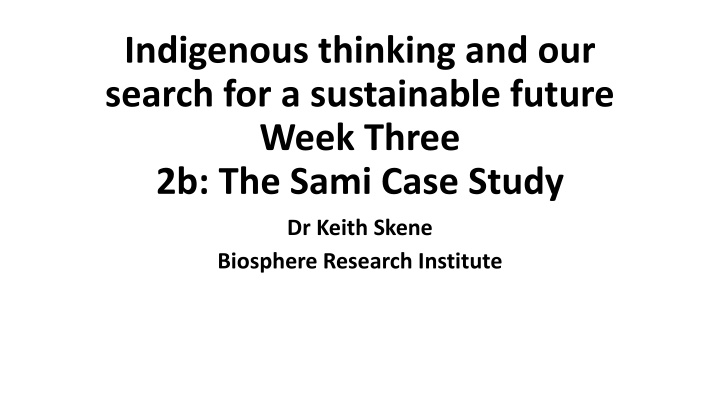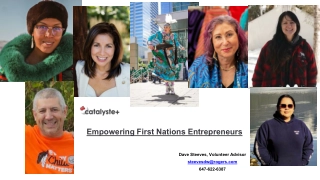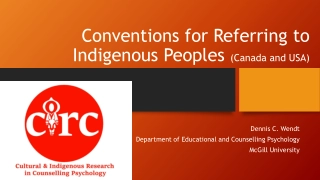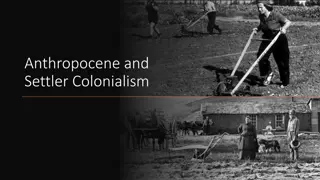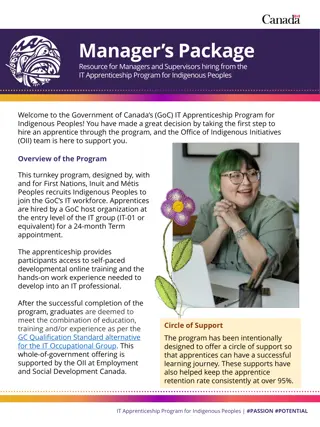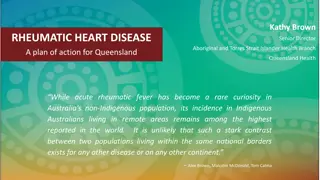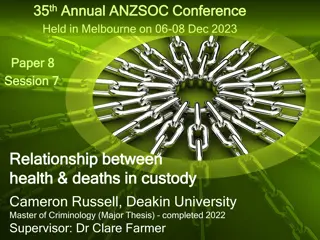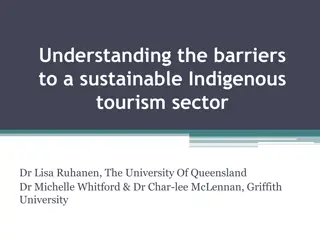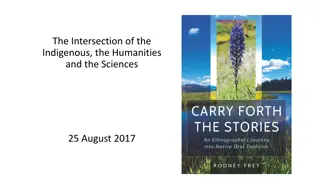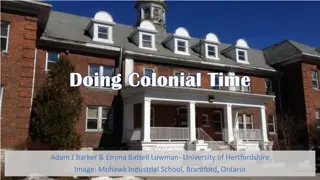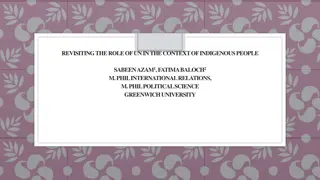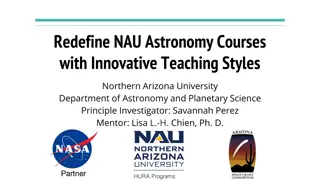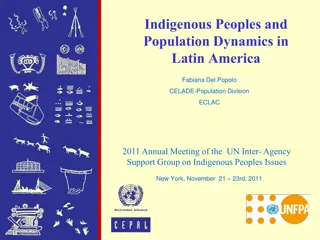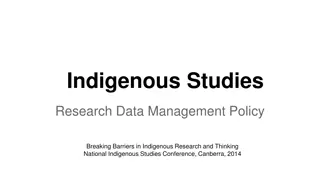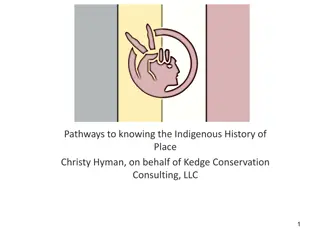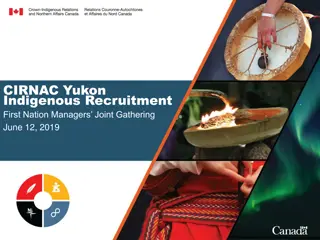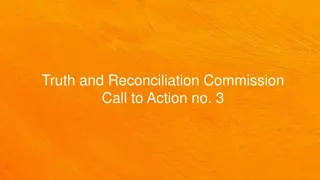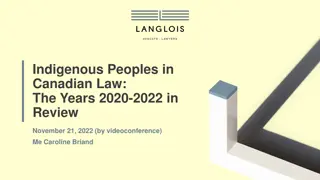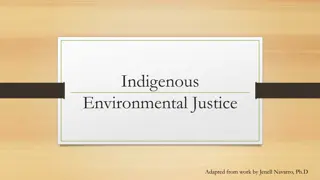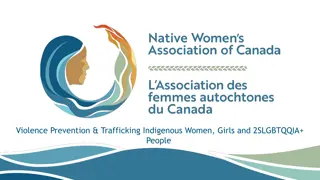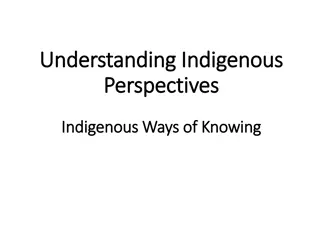Indigenous Thinking for Sustainable Future: The Sami Case Study
The Sami people, spread across Norway, Sweden, Finland, and Russia, showcase a unique cultural heritage with diverse linguistic traditions and a sustainable governance system centered around the gifting concept. Their deep connection with nature and the land reflects in their holistic approach towards sustainability. Explore how the Sami community values the gifts from nature, upholding a balanced relationship with the Earth.
Download Presentation

Please find below an Image/Link to download the presentation.
The content on the website is provided AS IS for your information and personal use only. It may not be sold, licensed, or shared on other websites without obtaining consent from the author.If you encounter any issues during the download, it is possible that the publisher has removed the file from their server.
You are allowed to download the files provided on this website for personal or commercial use, subject to the condition that they are used lawfully. All files are the property of their respective owners.
The content on the website is provided AS IS for your information and personal use only. It may not be sold, licensed, or shared on other websites without obtaining consent from the author.
E N D
Presentation Transcript
Indigenous thinking and our search for a sustainable future Week Three 2b: The Sami Case Study Dr Keith Skene Biosphere Research Institute
The Sami The Sami are spread across Norway, Sweden, Finland and Russia, totalling around 100 000 individuals. S pmi is the cultural region traditionally inhabited by the Sami people.
Linguistics The Sami themselves have nine languages They should be considered as a commonwealth rather than a single culture Within each linguistic grouping there have been various sub-groups, specializing in a particular type of activity, such as reindeer herding, settled farming or fishing.
Lhi and attldat: the importance of the gifting process The Sami have an effective whole-of-Earth system of governance and values that have sustained and protected safe operating spaces on Earth for millennia At the heart of this set of values lies the gifting concept, found throughout the indigenous world Among the Sami people, this comprising of two key aspects, l hi and att ldat.
Lhi L hi represents the gifts from nature, given to us through the complex interconnected Earth system, and the sharing of these gifts. The Sami, like so many other indigenous people, recognize that these provisions sustain them and that the Earth system deserves respect Nature is not possessed nor owned by cultivation, as Locke would have us believe
Cree people in North-eastern Canada Similar landscape to Sami Within their cosmology, the Caribou, on whom they rely upon for sustenance, intentionally present themselves as food to the hunters This is interpreted simultaneously as a gift and as an indication that the relationship between humans, caribou and the wider environment is in good health.
Cree Nation banned Caribou hunting at George River Herd population is estimated to be 8,100 animals in 2020, up from 5,500 in 2018 Following a huge collapse
From this attentiveness to the relationships between human communities and the caribou, and in the care practiced in the consumption and distribution of the gift of meat, emerges an organic ethic of conservation which goes deeper than the management of natural resources.
Gifting as a flow of power We can interpret gifting as a current or flow of power that empowers the community, providing them with sustenance It is a process of enabling, enfolding and of unfolding akin to ubuntu The interconnectivity of all gives identity and purpose, acting as a path towards wellbeing and a meaningful life.
Seasonality In seasonal landscapes, such as Northern Scandinavia, the gifting is seasonal and cyclical, often involving transhumance So many indigenous populations embrace this cycle in their customs.
The rhythms of nature Traditional knowledge represents the embodiment of these temporal and spatial aspects Wherein the integrity of the Earth system, replete with its patterns and emergent character, is a living being in and of itself The rhythms of nature encompass the rhythms of the people.
Robin Wall Kimmerer observes that: From the viewpoint of a private property economy, the 'gift' is deemed to be 'free' because we obtain it free of charge, at no cost. But in the gift economy, gifts are not free The essence of the gift is that it creates a set of relationships The currency of a gift economy is, at its root, reciprocity In Western thinking, private land is understood to be a 'bundle of rights, whereas in a gift economy property has a bunch of responsibilities attached.
Attldat The second aspect gifting is att ldat This represents the gifting or sharing of the individual skills a person possesses The Sami believe that each of us has something to offer, and we are obliged to contribute our skills and abilities for the benefit of the community as a whole.
Recognizing what our skills are is part of the unfolding of our character (as in ubuntu), which occurs through being embedded within the circle of power To be empowered is to understand ourselves and what we can offer The process of unfolding lies at the heart of the contextualization of ourselves, Mentally, physically and spiritually, within the greater whole.
Kimmerer: Reciprocity is a matter of keeping the gift [from nature] in motion through self-perpetuating cycles of giving and receiving; Through reciprocity the gift is replenished. All of our flourishing is mutual. This sense of interrelatedness and reciprocity ( returning the gift ) relies on the idea of a genealogical network, where nature is not perceived in terms of resources, but as full of relatives .
Revisioning wealth where no member of the network is allowed to dominate or is the only responsible for nature And where wealth is understood in terms of the number and quality of relationships one is able to maintain within the network.
The relational self All are tied together in one, and l hi and att ldat can be seen as facilitating the empowerment of all Here the relational self encompasses both the human and non- human elements of the Earth system.
Power and Empowerment Power is not a thing to be possessed or owned, as in Western tradition, but rather it flows through all, connecting landscape, energy and society. Empowerment, then, can be seen as being an emergent property of this cycle of power Process not possession.
Sieidis Indigenous gift economies cross the divide between human and non- human, including geology (such as the sieidis in the Sami tradition, which are stones or wood on which sacrifices are made).
Gift economy Locally-centred gift economies strengthen community resilience while buffering against instability delivered by global models at the local level, where globalization increases risk exposure Rather, the gift economy embraces the socio-cosmic order.
Gift economics is anchored within this over-arching philosophy of integrated living, allowing the flow of power rather than the possession of it.
Godbout and Caille (1998: 133) write that The gift economy is based on a different logic that perceives the world as being inhabited by autonomous but interrelated powers and entities that cannot be subjugated .
If the gifting is the conduit of power, rather than a token of the material world then it eludes value, provided that the receiver acts, themselves, as a conduit and that the gift merely contributes to the transmission of power, within the cycle of power This represents true equality.
Marlene Brant Castellano The Mohawk philosopher, Castellano (2000: 30), notes that through the sharing of diverse gifts, balance is created in individual lives and in society as a whole Here the economy facilitates wellbeing and social sustainability
Relational empowerment as the basis of sustainability Without the interconnectivity across environment and community Any effort at building environmental and social resilience and sustainability will fail Both in indigenous and modern communities Relational empowerment is an emergent property and cannot be constructed using Western, empirical thinking.
Economic Pluriverse Beth Povinelli recognizes the significant issues surrounding globalism and economics, observing that reconciliation with multiculturalism ends where a conceptual accommodation to a multi-economism would begin.
Thus, traditional knowledge now provides the solution space, not in terms of actions, but in terms of processes and foundations. The Earth system itself is a pluriverse, since natural ecosystems do not aspire to convert other ecosystems to their way of doing things, but rather a whole series of ecosystems types are expressed locally, fitting the environment and evolving within that environment With an appropriate economy.
Issues with competition-driven economics The existing system of competing national states and multinational corporations organized on the basis of market competition is patently inadequate to the purposes of conservation, sustainability and, ultimately, species survival.
Makere Stewart-Harawira (2005) claims that far from [being] irrelevant in the modern world, traditional indigenous social, political and cosmological ontologies are profoundly important to the development of transformative alternative frameworks for global order and new ways of being .
Think Local, Act Local, Reflecting Global The idea of thinking globally while acting locally has been attributed to Sir Patrick Geddes In his book, Cities in Evolution (Geddes 1915), he emphasised the significance of the historic aspects of place, folk and work at the local level
He applied this general principle to his urban planning practices many times, wherein the history, culture and landscape, that shaped the evolution of a place in the first instance, must not be thrown away when re-envisaging a future, but, rather, are the very wellsprings from which the essence of a city must re- emerge.
And it was the local community who held within them the knowledge with which to move forward, in resonance with these foundations His concept of utilizing the history and traditions of the community while proposing a project that could be related to the contemporary world, would lead to the concept of glocal .
The invisible hand The global Earth system reaches in to the local landscape, society and individuals It shapes them and unfolds them, and thus the local reflects these global processes and flows The local is the expression of the global in a given landscape Where the global acts as an invisible hand.
The Earth System Yet the global is more than a blueprint setting out how the local should be The Earth is a system, and everything impacts on everything else Emergence is key here, rather than any concept of building blocks Self-organization and actuation are complex and non-linear properties
This course suggests that the fundamental reason that a core set of indigenous principles, values and ethics, is reflected across so many indigenous ideologies and practice is because it emerges from the interaction of ecologically intelligent populations finding the global within the local.
World Religions Importance of light and darkness Good and Evil Controlling invisible entities Cultural expressions structures and behavioural rules
There are universal traits, patterns and cycles emerging from the Earth system that are recognized across the globe by humans who are integrated with that system through their landscapes, environments and social interactions Hence, by thinking local and acting local, we resonate with the greater global whole in a convergent way.
The local and the global The local is an expression of the global within a given set of contexts Not only is the whole an emergent entity, but so are the component parts, each within each other
The integrated nature of Nature Thus, many of the principles that allow sustainable living in one landscape are equally relevant to any other landscape there are global aspects such as food chains, population dynamics, predator-prey relationships, hygiene and water management that cut across all landscapes
Platos universal forms These global patterns and the interwoven nature of the Earth system, governed by the universal laws of physics, but expressed within a local context, embrace both continuity and adventitiousness, cyclic and emergent. Resilience comes from the integrated nature of Nature Akin to Ubuntu (enfolded and unfolded).
The global is within the local and the local is within the global This is not so much a think globally, act locally framework, But, rather, a resonance with the greater Earth system, which is expressed locally but shaped and driven at a global level. Fundamentally, this course suggests that indigenous philosophy and practice could be described rather as think local, act local The global is only recognized when comparative studies are made For the global is in the local, and so the local offers everything that is needed.
Theophilus Okere African Philosopher All philosophy is local and even individual before it can be universal; and nothing can be genuinely universally valid unless it was first authentically personal and inserted within a given culture. If this is the case for philosophy, it is likely to be the case for human knowledge, since every form of human knowledge must be situated or generated from within a culture or bounded by presuppositions, prejudgments, interests etc.
This is indeed profound highlighting a much deeper understanding of the pluriverse and of the importance of diversity, produced through the unfolded wealth of individual perception, whose unfolding requires us to be relationally empowered, as in Ubuntu and the gift economy.
Bio-participation Wellbeing is rooted, not in individual wealth, education and health, but in interconnectivity and flow of ecological power. Geddes (1915) writes that Healthy life is completeness of relation of organism, function, and environment, and all at their best . Nature is an emergent synergy, contextualizing our existence and requiring sub-optimality, humility and gifting To be one with Nature is not some underdeveloped, primitive state of being Rather, it reflects true humanity, unfolded within this deeper context.
We see reference to the flow of energy through the whole landscape, cycling through time, and the tying together of individual, community and environment, past and present, through recognition of the gifts from nature and our response in terms of giving, through our individually unfolded, diverse skillsets, to the community.
